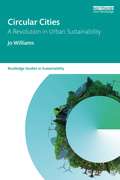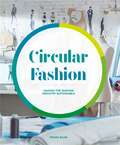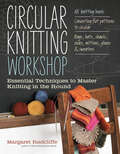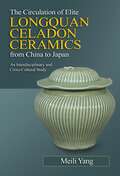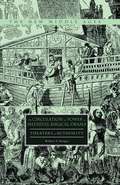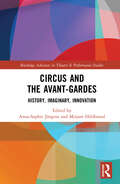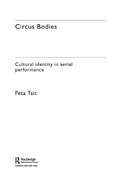- Table View
- List View
Circles and Squares: The Lives and Art of the Hampstead Modernists
by Caroline MacleanA spellbinding portrait of the Hampstead Modernists, threading together the lives, loves, rivalries and ambitions of a group of artists at the heart of an international avant-garde.Hampstead in the 1930s. In this peaceful, verdant London suburb, Barbara Hepworth and Ben Nicholson have embarked on a love affair – a passion that will launch an era-defining art movement. In her chronicle of the exhilarating rise and fall of British Modernism, Caroline Maclean captures the dazzling circle drawn into Hepworth and Nicholson's wake: among them Henry Moore, Paul Nash, Herbert Read, and famed émigrés Walter Gropius, founder of the Bauhaus, and Piet Mondrian, blown in on the winds of change sweeping across Europe. Living and working within a few streets of their Parkhill Road studios, the artists form Unit One, a cornerstone of the Modernist movement which would bring them international renown. Drawing on previously unpublished archive material, Caroline Maclean's electrifying Circles and Squares brings the work, loves and rivalries of the Hampstead Modernists to life as never before, capturing a brief moment in time when a new way of living seemed possible. United in their belief in art's power to change the world, her cast of trailblazers radiate hope and ambition during one of the darkest chapters of the twentieth century.
Circles of Thorns: Hieronymus Bosch and Being Human
by Justin Lewis-AnthonyUnlike Bosch's better-known, fantastical, 'proto-surrealist' paintings, Christ Mocked is small, still and sombre, and yet, with a little effort of knowledge and interpretation, it reveals a depth of understanding of both the Passion, and of human nature, that speaks as much to the twenty-first century as it did to the sixteenth. By exploring the political, scientific, psychological and devotional world of early modern Europe, and applying those insights to our own time, the author shows how Bosch used his sophisticated artistic skills to convey a similarly sophisticated understanding of humanity. In Christ Mocked -- a painting "500 years old but passionately modern" -- Christ's Passion is so portrayed as to make us reassess the cosmic significance of Christ's death, and its profound implications for what we think it means to be human.
Circular Cities: A Revolution in Urban Sustainability (Routledge Studies in Sustainability)
by Jo WilliamsWith cities striving to meet sustainable development goals, circular urban systems are gaining momentum, especially in Europe. This research-based book defines the circular city and circular development. It explains the shift in focus from a purely economic concept, which promotes circular business models in cities, to one that explores a new approach to urban development. This approach offers huge opportunities and addresses important sustainability issues: resource consumption and waste; climate change; the health of urban populations; social inequalities and the creation of sustainable urban economies. It examines the different approaches to circular development, drawing on research conducted in four European cities: Amsterdam, London, Paris and Stockholm. It explores different development pathways and levers for a circular urban transformation. It highlights the benefits of adopting a circular approach to development in cities, but acknowledges that these benefits are not shared equally across society. Finally, it focuses on the challenges to implementing circular development faced by urban actors. This ground-breaking book will be essential reading to scholars, students, practitioners and policymakers interested in the circular economy, urban sustainability, urban ecology, urban planning, urban regeneration, urban resilience, adaptive cities and regenerative cities.
Circular Cities: A Revolution in Urban Sustainability (Routledge Studies in Sustainability)
by Jo WilliamsWith cities striving to meet sustainable development goals, circular urban systems are gaining momentum, especially in Europe. This research-based book defines the circular city and circular development. It explains the shift in focus from a purely economic concept, which promotes circular business models in cities, to one that explores a new approach to urban development. This approach offers huge opportunities and addresses important sustainability issues: resource consumption and waste; climate change; the health of urban populations; social inequalities and the creation of sustainable urban economies. It examines the different approaches to circular development, drawing on research conducted in four European cities: Amsterdam, London, Paris and Stockholm. It explores different development pathways and levers for a circular urban transformation. It highlights the benefits of adopting a circular approach to development in cities, but acknowledges that these benefits are not shared equally across society. Finally, it focuses on the challenges to implementing circular development faced by urban actors. This ground-breaking book will be essential reading to scholars, students, practitioners and policymakers interested in the circular economy, urban sustainability, urban ecology, urban planning, urban regeneration, urban resilience, adaptive cities and regenerative cities.
Circular Economy for Buildings and Infrastructure: Principles, Practices and Future Directions (Sustainable Development Goals Series)
by Liyin Shen Jian Zuo Ruidong ChangThis edited volume covers theoretical and practical aspects of circular economy in building development, offering chapters dealing with topics such as material design, affordability of housing development, waste management and recycling, smart metering, and more. A particular focus is placed on various stakeholders’ points of view. The book's chapters are co-developed and contributed by multidisciplinary teams including both academics and industry practitioners. The case study-oriented approach taken here helps to facilitate the reader's understanding of how building sustainability can be achieved in the context of circular economy. The building industry has significant environmental, social and economic impacts. As one of the biggest energy consumers and carbon emitters, building sustainability has attracted wide attention globally. Building projects and their associated activities consume a large amount of energy, natural resources and water while producing a large proportion of wastes throughout their lifecycles. The traditional linear approach of “make, use and dispose” has been heavily criticized, whilst the circular approach has gained momentum. Indeed, circular economy has emerged as one of key principles to manage sustainability related issues by means of focusing on the circularity of resources as well as the cost implications.
Circular Economy in Emergency Housing: A Research Strategy of Climate Change (SpringerBriefs in Climate Studies)
by Pilar Mercader-Moyano Paula Porras-PereiraIn recent years, there has been an upsurge in the number of forced displacements due to natural disasters, armed conflicts, and pandemics, which has favoured an increase in the number of temporary accommodations. Although the provision of shelter after an emergency situation is one of the priorities of humanitarian aid, the reality is that the conditions in which people live in a situation of forced displacement are absolutely precarious and overcrowded. Nowadays, this type of housing tends to have a short lifespan, deepening the environmental impact and the generation of waste. Likewise, added to this great problem is the linear economic system implemented worldwide, which also causes a high rate of waste.This investigation develops an eco-efficient design protocol that determines the basic premises in any emergency situation, therefore avoiding the precarious nature to which those in forced displacement are exposed. Moreover, the research investigates different constructive solutions that can respond to situations of natural catastrophes or humanitarian disasters where emergency housing is needed as well as the possible alternatives from the point of view of circular economy. Eco-efficient and environmentally correct solutions are sought, which can be adaptable to the different scenarios where emergency housing may be needed, thus creating a rapid, easy, functional, and environmentally correct architecture, adaptable to these types of situations. The study shows that the factors that characterize emergency architecture can be an example of where the issues around the sustainability factor are applied in a practical way. The main objectives of this study are to develop an eco-efficient design protocol which determines the basic premises in any emergency situation and to find eco-efficient and environmentally correct solutions, adaptable to different scenarios, which have similar climatic characteristics, and where emergency housing may be needed, thus creating a type of ephemeral architecture but sensitive to the user to whom it is intended and in accordance with the optimal conditions of habitability.
Circular Economy in Engineering Design and Production: Concepts, Methods, and Applications (Synthesis Lectures on Sustainable Development)
by Samira KeivanpourThis concise text provides the concepts, methods, and application examples for integrating sustainability into engineering design and production. It discusses the role of sustainability in the value creation processes of various enterprises and different tools and methods for systematic incorporation of social and environmental aspects into the product's life cycle. The following topics are covered: sustainable development in engineering systems and the life cycle concept, norms and standards in the sustainable development and integration of socio-economic assessment into technical valuation, production systems, management of the production systems based on circular economy principles, ecodesign practices, and value creation and innovative design in the circular economy. Provides a concise guide for engineering students for applying circular economy practicesPresents examples and short case studies for understanding the methods and toolsFacilitates understanding and application of the life cycle perspective in product manufacturing and green engineering
Circular Fashion: Making the Fashion Industry Sustainable
by Peggy BlumCreating sustainable fashion has never been more important. Circular Fashion provides an accessible, practical, and holistic approach to this key topic for anyone studying fashion.This introductory text to sustainability in fashion includes best practice case studies and profiles of key companies such as Patagonia, Veja, Christopher Raeburn, and Stella McCartney. It begins with an overview of the fashion business, tackling the issues of the linear production model of make, use, dispose, before introducing the idea of the circular supply chain.Circular Fashion is the must-have book for fashion students, creatives and anyone passionate about sustainability and fashion.
Circular Knitting Workshop: Essential Techniques to Master Knitting in the Round
by Margaret RadcliffeDiscover the pleasures of knitting in the round! Margaret Radcliffe presents classic circular knitting techniques — including Fair Isle, helix, and tubular — in detailed step-by-step photographic sequences. This comprehensive guide provides directions for 35 demonstration projects, so you can practice each technique on a miniature hat, mitten, or sweater before applying it to a larger project. With tips on how to adapt any straight-needle pattern for use with circular needles, Circular Knitting Workshop opens up endless possibilities.
Circulation and Control: Artistic Culture and Intellectual Property in the Nineteenth Century
by Marie-Stéphanie Delamaire And Will SlauterThe nineteenth century witnessed a series of revolutions in the production and circulation of images. From lithographs and engraved reproductions of paintings to daguerreotypes, stereoscopic views, and mass-produced sculptures, works of visual art became available in a wider range of media than ever before. But the circulation and reproduction of artworks also raised new questions about the legal rights of painters, sculptors, engravers, photographers, architects, collectors, publishers, and subjects of representation (such as sitters in paintings or photographs). Copyright and patent laws tussled with informal cultural norms and business strategies as individuals and groups attempted to exert some degree of control over these visual creations. With contributions by art historians, legal scholars, historians of publishing, and specialists of painting, photography, sculpture, and graphic arts, this rich collection of essays explores the relationship between intellectual property laws and the cultural, economic, and technological factors that transformed the pictorial landscape during the nineteenth century. This book will be valuable reading for historians of art and visual culture; legal scholars who work on the history of copyright and patent law; and literary scholars and historians who work in the field of book history. It will also resonate with anyone interested in current debates about the circulation and control of images in our digital age.
The Circulation of Elite Longquan Celadon Ceramics from China to Japan: An Interdisciplinary and Cross-Cultural Study
by Meili YangChinese Longquan celadon, a type of green-glazed ceramic, is one of the most famous branded and trade products, particularly during the 13th and 14th centuries. Its archaeological and historical materials possess multiple attributes with plentiful cultural information. The objective of the present book is to vivify these materials and provide a broader perspective and additional methodologies to review and gain a new and more profound understanding of Longquan celadon. The first part of this book focuses on elite Longquan celadon in China's Southern Song (1127-1278) and Yuan (1271-1368) periods. The second part focuses on elite Longquan celadon products as imports in medieval Japan. These products played a crucial role in shaping medieval Japanese culture.
The Circulation of Power in Medieval Biblical Drama: Theaters of Authority (The New Middle Ages)
by Robert S. SturgesA literary reading informed by the recent temporal turn in Queer Theory, this book analyzes medieval Biblical drama for themes representing modes of power such as the body, politics, and law. Revitalizing the discussions on medieval drama, Sturges asserts that these dramas were often intended not to teach morality but to resist Christian authority.
Circulations in the Global History of Art (Studies in Art Historiography)
by Catherine Dossin Thomas DaCosta Kaufmann Béatrice Joyeux-PrunelThe project of global art history calls for balanced treatment of artifacts and a unified approach. This volume emphasizes questions of transcultural encounters and exchanges as circulations. It presents a strategy that highlights the processes and connections among cultures, and also responds to the dynamics at work in the current globalized art world. The editors’ introduction provides an account of the historical background to this approach to global art history, stresses the inseparable bond of theory and practice, and suggests a revaluation of materialist historicism as an underlying premise. Individual contributions to the book provide an overview of current reflection and research on issues of circulation in relation to global art history and the globalization of art past and present. They offer a variety of methods and approaches to the treatment of different periods, regions, and objects, surveying both questions of historiography and methodology and presenting individual case studies. An 'Afterword' by James Elkins gives a critique of the present project. The book thus deliberately leaves discussion open, inviting future responses to the large questions it poses.
Circulations in the Global History of Art (Studies in Art Historiography)
by Catherine Dossin Thomas DaCosta Kaufmann Béatrice Joyeux-PrunelThe project of global art history calls for balanced treatment of artifacts and a unified approach. This volume emphasizes questions of transcultural encounters and exchanges as circulations. It presents a strategy that highlights the processes and connections among cultures, and also responds to the dynamics at work in the current globalized art world. The editors’ introduction provides an account of the historical background to this approach to global art history, stresses the inseparable bond of theory and practice, and suggests a revaluation of materialist historicism as an underlying premise. Individual contributions to the book provide an overview of current reflection and research on issues of circulation in relation to global art history and the globalization of art past and present. They offer a variety of methods and approaches to the treatment of different periods, regions, and objects, surveying both questions of historiography and methodology and presenting individual case studies. An 'Afterword' by James Elkins gives a critique of the present project. The book thus deliberately leaves discussion open, inviting future responses to the large questions it poses.
Circus and the Avant-Gardes: History, Imaginary, Innovation (Routledge Advances in Theatre & Performance Studies)
by Anna-Sophie Jürgens and Mirjam HildbrandThis book examines how circus and circus imaginary have shaped the historical avant-gardes at the beginning of the 20th century and the cultures they help constitute, to what extent this is a mutual shaping, and why this is still relevant today. This book aims to produce a better sense of the artistic work and cultural achievements that have emerged from the interplay of circus and avant-garde artists and projects, and to clarify both their transhistorical and trans-medial presence, and their scope for interdisciplinary expansion. Across 14 chapters written by leading scholars – from fields as varied as circus, theatre and performance studies, art, media studies, film and cultural history – some of which are written together with performers and circus practitioners, the book examines to what extent circus and avant-garde connections contribute to a better understanding of early 20th century artistic movements and their enduring legacy, of the history of popular entertainment, and the cultural relevance of circus arts. Circus and the Avant-Gardes elucidates how the realm of the circus as a model, or rather a blueprint for modernist experiment, innovation and (re)negotiation of bodies, has become fully integrated in our ways of perceiving avant-gardes today. The book does not only map the significance of circus/avant-garde phenomena for the past, but, through an exploration of their contemporary actualisations (in different media), also carves out their achievements, relevance, and impact, both cultural and aesthetic, on the present time.
Circus and the Avant-Gardes: History, Imaginary, Innovation (Routledge Advances in Theatre & Performance Studies)
by Anna-Sophie Jürgens Mirjam HildbrandThis book examines how circus and circus imaginary have shaped the historical avant-gardes at the beginning of the 20th century and the cultures they help constitute, to what extent this is a mutual shaping, and why this is still relevant today. This book aims to produce a better sense of the artistic work and cultural achievements that have emerged from the interplay of circus and avant-garde artists and projects, and to clarify both their transhistorical and trans-medial presence, and their scope for interdisciplinary expansion. Across 14 chapters written by leading scholars – from fields as varied as circus, theatre and performance studies, art, media studies, film and cultural history – some of which are written together with performers and circus practitioners, the book examines to what extent circus and avant-garde connections contribute to a better understanding of early 20th century artistic movements and their enduring legacy, of the history of popular entertainment, and the cultural relevance of circus arts. Circus and the Avant-Gardes elucidates how the realm of the circus as a model, or rather a blueprint for modernist experiment, innovation and (re)negotiation of bodies, has become fully integrated in our ways of perceiving avant-gardes today. The book does not only map the significance of circus/avant-garde phenomena for the past, but, through an exploration of their contemporary actualisations (in different media), also carves out their achievements, relevance, and impact, both cultural and aesthetic, on the present time.
Circus balancing act (Large Print)
This page shows two circus acrobats. The first acrobat stands facing forward at the bottom of the page, while the second one balances upside down, on one hand, on the first acrobat's head. There is a locator dot shown, which will be at the top left of the page when the image is the right way up. At the bottom of the page are the feet of the first acrobat, who is supporting the second acrobat. Above these are his legs wearing tights, and his bare chest. Up again are his strong shoulders with his arms held out wide to the left and right, to make his stance more stable. He wears bands on his wrists to reduce the risk of injury. His head is bearing the weight of the second acrobat further up the page who is balancing on one hand. The second acrobat wears a band on his wrist, and his arm continues vertically up the page. To the right of this his upside-down head can be found, and to the right again is his other arm wearing a wristband. Up the page from his head are his bare chest and his two legs stretched out to the left and right to help him balance.
Circus balancing act (UEB Contracted)
This page shows two circus acrobats. The first acrobat stands facing forward at the bottom of the page, while the second one balances upside down, on one hand, on the first acrobat's head. There is a locator dot shown, which will be at the top left of the page when the image is the right way up. At the bottom of the page are the feet of the first acrobat, who is supporting the second acrobat. Above these are his legs wearing tights, and his bare chest. Up again are his strong shoulders with his arms held out wide to the left and right, to make his stance more stable. He wears bands on his wrists to reduce the risk of injury. His head is bearing the weight of the second acrobat further up the page who is balancing on one hand. The second acrobat wears a band on his wrist, and his arm continues vertically up the page. To the right of this his upside-down head can be found, and to the right again is his other arm wearing a wristband. Up the page from his head are his bare chest and his two legs stretched out to the left and right to help him balance.
Circus balancing act (UEB uncontracted)
This page shows two circus acrobats. The first acrobat stands facing forward at the bottom of the page, while the second one balances upside down, on one hand, on the first acrobat's head. There is a locator dot shown, which will be at the top left of the page when the image is the right way up. At the bottom of the page are the feet of the first acrobat, who is supporting the second acrobat. Above these are his legs wearing tights, and his bare chest. Up again are his strong shoulders with his arms held out wide to the left and right, to make his stance more stable. He wears bands on his wrists to reduce the risk of injury. His head is bearing the weight of the second acrobat further up the page who is balancing on one hand. The second acrobat wears a band on his wrist, and his arm continues vertically up the page. To the right of this his upside-down head can be found, and to the right again is his other arm wearing a wristband. Up the page from his head are his bare chest and his two legs stretched out to the left and right to help him balance.
Circus Bodies: Cultural Identity in Aerial Performance
by Peta TaitThis pioneering study is one of the major publications in the increasingly popular and largely undocumented area of circus studies. Through photographs and illustrations, Peta Tait presents an extraordinary survey of 140 years of trapeze acts and the socially changing ideas of muscular action in relation to our understanding of gender and sexuality. She questions how spectators see and enjoy aerial actions, and what cultural identities are presented by bodies in fast, physical aerial movement. Adeptly locating aerial performance within the wider cultural history of bodies and their identities, Circus Bodies explores this subject through a range of films such as Trapeze (1956) and Wings of Desire (1987) and Tait also examines live performances including: * the first trapeze performers: Léotard and the Hanlon Brothers* female celebrities; Azella, Sanyeah, black French aerialist LaLa, the infamous Leona Dare, and the female human cannonballs* twentieth-century gender benders; Barbette and Luisita Leers* the Codonas, Concellos, Gaonas, Vazquez and Pages troupes* imaginative aerial acts in Cirque de Soleil and Circus Oz productions. This book will prove an invaluable resource for all students and scholars interested in this fascinating field.
Circus Bodies: Cultural Identity in Aerial Performance
by Peta TaitThis pioneering study is one of the major publications in the increasingly popular and largely undocumented area of circus studies. Through photographs and illustrations, Peta Tait presents an extraordinary survey of 140 years of trapeze acts and the socially changing ideas of muscular action in relation to our understanding of gender and sexuality. She questions how spectators see and enjoy aerial actions, and what cultural identities are presented by bodies in fast, physical aerial movement. Adeptly locating aerial performance within the wider cultural history of bodies and their identities, Circus Bodies explores this subject through a range of films such as Trapeze (1956) and Wings of Desire (1987) and Tait also examines live performances including: * the first trapeze performers: Léotard and the Hanlon Brothers* female celebrities; Azella, Sanyeah, black French aerialist LaLa, the infamous Leona Dare, and the female human cannonballs* twentieth-century gender benders; Barbette and Luisita Leers* the Codonas, Concellos, Gaonas, Vazquez and Pages troupes* imaginative aerial acts in Cirque de Soleil and Circus Oz productions. This book will prove an invaluable resource for all students and scholars interested in this fascinating field.
Circus Psychology: An Applied Guide to Thriving Under the Big Top
by Fleur van RensThe lives of circus artists can be mentally and physically demanding. Circus Psychology: An Applied Guide to Thriving Under the Big Top is an evidence-based guide to nurturing the mental health of circus artists while enabling them to perform at the peak of their capacities. The book is organised into three accessible sections: mental health in circus, optimising the circus environment to facilitate thriving, and mental skills for thriving in circus. The first section introduces general mental health concepts, provides insight into the mental health of circus artists, the stress process, and the role of psychological resilience and perfectionism in mental health. The second section offers insight into motivation and engagement in circus, the features of a psychologically safe circus environment, and advice on psychologically supportive talent development environment. The final section explains, applies, and provides practice material for mental skills, including goal setting, self-talk, mental imagery, arousal regulation, and visual anticipation. Written by Dr Fleur van Rens, a circus artist and lecturer in sport psychology, this book is an essential resource for those passionate about the mental health of amateurs and professionals in the circus industry.
Circus Psychology: An Applied Guide to Thriving Under the Big Top
by Fleur van RensThe lives of circus artists can be mentally and physically demanding. Circus Psychology: An Applied Guide to Thriving Under the Big Top is an evidence-based guide to nurturing the mental health of circus artists while enabling them to perform at the peak of their capacities. The book is organised into three accessible sections: mental health in circus, optimising the circus environment to facilitate thriving, and mental skills for thriving in circus. The first section introduces general mental health concepts, provides insight into the mental health of circus artists, the stress process, and the role of psychological resilience and perfectionism in mental health. The second section offers insight into motivation and engagement in circus, the features of a psychologically safe circus environment, and advice on psychologically supportive talent development environment. The final section explains, applies, and provides practice material for mental skills, including goal setting, self-talk, mental imagery, arousal regulation, and visual anticipation. Written by Dr Fleur van Rens, a circus artist and lecturer in sport psychology, this book is an essential resource for those passionate about the mental health of amateurs and professionals in the circus industry.
Circus Ringmaster (Large Print)
This is a picture of the circus ringmaster in his traditional costume holding a whip. He is standing facing forward in the middle of the page so all his limbs and facial features can be seen. There is a locator dot shown, which will be at the top left of the page when the image is the right way up. At the top of the page is the ringmaster's tall top hat with some wisps of hair sticking out. Just down the page is his face with two eyes, nose and mouth visible. Down again are his bow tie, shirt and three-buttoned waistcoat. To either side are the lapels of his long frock coat, which comes down to his waist at the front and to his knees at the back. It has two buttons to the left of the waistcoat buttons. His arms are held out wide, the one to the right is holding the whip. Further down the page the ringmaster wears long trousers tucked into his long leather riding boots.
Circus Ringmaster (UEB Contracted)
This is a picture of the circus ringmaster in his traditional costume holding a whip. He is standing facing forward in the middle of the page so all his limbs and facial features can be seen. There is a locator dot shown, which will be at the top left of the page when the image is the right way up. At the top of the page is the ringmaster's tall top hat with some wisps of hair sticking out. Just down the page is his face with two eyes, nose and mouth visible. Down again are his bow tie, shirt and three-buttoned waistcoat. To either side are the lapels of his long frock coat, which comes down to his waist at the front and to his knees at the back. It has two buttons to the left of the waistcoat buttons. His arms are held out wide, the one to the right is holding the whip. Further down the page the ringmaster wears long trousers tucked into his long leather riding boots.


